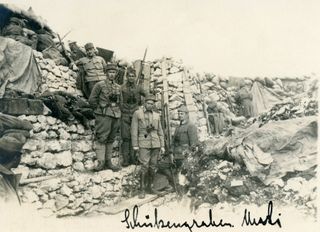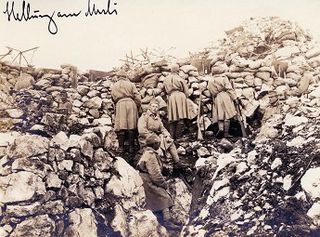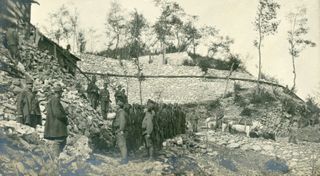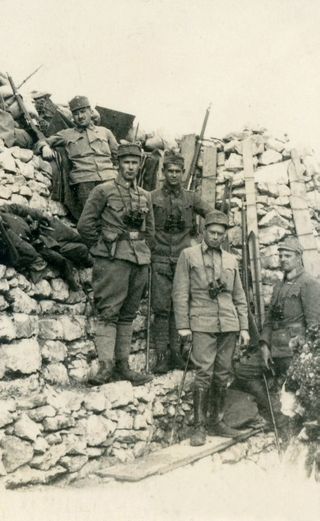Austro-Hungarian Army in the Upper Soča Region, III - 25.5.1915 – 23.10.1917
22.10.2022 - 12.10.2023In 2016, our thematic exhibition led us to the positions and the rear of the Austro-Hungarian Army in the Bovec area. In 2019, we then continued our journey to the Krn range, whereas this year we are concluding it on the southern part of the battlefield, in the foothills of the Julian Alps.
In the Upper Soča Region, the advance of the Italian Army was stopped by the units of the Austro-Hungarian Army Corps XV, the mountain brigades that had previously fought on the Balkan battlefield. On the left bank of the Soča, two neighbouring mountains, Sleme (1,482 m) and Mrzli vrh (1,360 m), were the pillars of defence. The latter in particular gained a bad reputation because of the numerous casualties among the Italian soldiers so that, despite its modest height, it was marked on large wall maps after the war. On the right bank of the river, the Tolmin bridgehead with the two low hills of Mengore (Sveta Marija) (457 m) and Cvetje (Selski vrh 588 m), called Santa Lucia by the Italians, gained the same bad reputation.
In the entire area, the defenders took advantage of their defence led from higher positions, while the numerically far superior units of the Italian Army found themselves in a hopeless situation, being exposed on the steep slopes. The effect of deadly weapons was further aggravated by natural forces, since in the two extremely severe winters during the war the soldiers had to face the conditions of high-altitude warfare despite the lower elevations.
The events at Sleme, Mrzli vrh and in the rear have already been presented at thematic exhibitions of the past decades, always with a prevailing share of records by the members of the Italian Army. This is natural due to the abundancy of Italian archival, private and published materials. The battalions of the Austro-Hungarian Mountain Brigades came mainly from distant areas of the Empire, and their members’ records are out of reach of the authors of the exhibitions. A notable exception at the preceding exhibition were long letters written by the artillery observer Ivo Brlić to his mother, the world-famous writer Ivana Mažuranić Brlić. This time, too, authors of certain descriptions of the battlefield, the Austro-Hungarian positions and actions were Italians. A more detailed explanation is given to visitors by the museum guides in the Kobarid Museum itself and on the former battlefield, often in two outdoor museums which were set up on the Walk of Peace from the Alps to the Adriatic at Mrzli vrh and Mengore by the Walk of Peace in the Soča Region Foundation.
Welcome!




